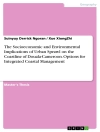This book presents decade-long advances in atmospheric research in the Mackenzie River Basin in northern Canada, which encompasses environments representative of most cold areas on Earth. Collaborative efforts by a team of about 100 scientists and engineers have yielded knowledge entirely transferable to other high latitude regions in America, Europe and Asia. Emphases are placed on the investigation of processes (including storm genesis, precipitation, moisture and energy fluxes and frost), and the improvement and application of a suite of models and remote sensing to enhance the assessment of climate variability and water resources. This book complements the first volume coming from the GEWEX project, dealing with the region’s atmospheric dynamics. Together these books provide a unique synthesis of atmospheric and hydrological findings and an integrative approach across disciplines in addressing major research issues of cold regions.
Inhaltsverzeichnis
Synopsis of Atmospheric Research under MAGS.- MAGS Contribution to Hydrologic and Surface Process Research.- Analysis and Application of 1-km Resolution Visible and Infrared Satellite Data over the Mackenzie River Basin.- On the Use of Satellite Passive Microwave Data for Estimating Surface Soil Wetness in the Mackenzie River Basin.- Studies on Snow Redistribution by Wind and Forest, Snow-covered Area Depletion, and Frozen Soil Infiltration in Northern and Western Canada.- Snowmelt Processes and Runoff at the Arctic Treeline: Ten Years of MAGS Research.- Modeling Maximum Active Layer Thaw in Boreal and Tundra Environments using Limited Data.- Climate-Lake Interactions.- Modeling Lake Energy Fluxes in the Mackenzie River Basin using Bulk Aerodynamic Mass Transfer Theory.- The Time Scales of Evaporation from Great Slave Lake.- Interannual Variability of the Thermal Components and Bulk Heat Exchange of Great Slave Lake.- Flow Connectivity of a Lake-Stream System in a Semi-arid Precambrian Shield Environment.- Hydrology of the Northwestern Subarctic Canadian Shield.- Recent Advances Toward Physically-based Runoff Modeling of the Wetland-dominated Central Mackenzie River Basin.- River Ice.- Regression and Fuzzy Logic Based Ice Jam Flood Forecasting.- Impact of Climate Change on the Peace River Thermal Ice Regime.- Climate Impacts on Ice-jam Floods in a Regulated Northern River.- Trends in Mackenzie River Basin Streamflows.- Re-Scaling River Flow Direction Data from Local to Continental Scales.- Lessons from Macroscale Hydrologic Modeling: Experience with the Hydrologic Model SLURP in the Mackenzie Basin.- Development of a Hydrologic Scheme for Use in Land Surface Models and its Application to Climate Change in the Athabasca River Basin.- Validating Surface Heat Fluxes and Soil Moisture Simulated by the Land Surface Scheme CLASS under Subarctic Tundra Conditions.- The MAGS Integrated Modeling System.- Synopsis of Mackenzie GEWEX Studies on the Atmospheric-Hydrologic System of a Cold Region.
Über den Autor
Ming-ko Woo is Professor of Geography at Mc Master University in Hamilton, Ontario, Canada. He serves on Editorial Board of the journal
Nordic Hydrology and as Associate Editor for the journals
Physical Geography and
Geographie Physique et Quaternaire. Additionally, he is the Vice Chairman of the International Geographical Union, Commission/Study Group on Water Sustainability.












